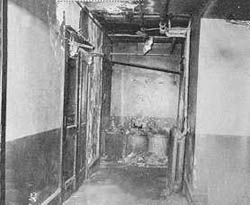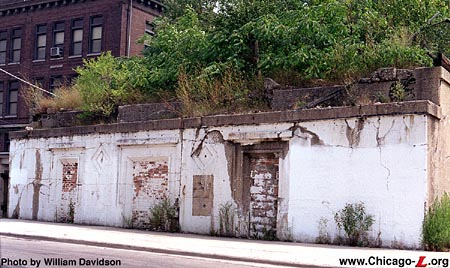|
History:

Interior views of
the Vincennes station, showing how dilapidated they
stations got by the time of their closure in the
1950s. (Photo from the
Chicago Transit Authority
Collection)
|
This simple concrete-and-steel station was typical of those
found on the Kenwood branch. Its concrete island floor and
simple canopy latticework suited the largely unoccupied
neighborhood at the time of its construction. The station
houses, one at the east end of the station at Drexel and one
at the west end at Cottage Grove, were molded into the
concrete embankment. Never lavish by any standards, their
exterior's were plain concrete with three doors (the main
double-doors in the center flanked by two smaller doors)
decorated only by a simple pediment over each entrance.
Inside, amenities were minimal or nonexistent. The walls
were concrete or (usually badly-water damaged) plaster with
some wood moldings. Lighting was incandescent and the
interior was broken up by naked steel I-beams. Only a simple
wooden fare booth usually broke up the floor space.
Developers responded to the new line by building elegant
new apartments (especially along scenic Drexel Boulevard)
and converting single family dwellings into multifamily
boarding houses. During this early development, the
neighborhood was quite white collar, including many German
Jews, Irish and English workers. By the 1930s, an increasing
number of transients and single persons populated the
neighborhood, followed by large numbers of African Americans
in the 1940s. Stock Yards workers were common here too.
By the mid-1950s, it was becoming apparent that falling
ridership and increasing deterioration of the Kenwood Line
would require some sort of immediate action. Three plans
were formulated for how to continue service - purchasing the
route from the Chicago Junction Railway (from whom CTA
rented the property), leasing it from the CJRwy, and
purchase by an outside agency for CTA use - but all of these
included modernization of the Kenwood stations. As part of a
$3,100 modernization plan covering both the Kenwood and
Stock Yards Lines, drawings dated July 13, 1956 show that
the CTA planned to minimize and streamline the stations to
achieve maximize usage with as little operations costs as
possible. The two side doors of the Cottage Grove entrance
were to be sealed with transite and the doors of the center
passage were to be removed. Floor-to-ceiling cornerless
transit walls were to be used to partition off the interior
of the station house, creating only a passageway from the
door up to the stairs to the platform. Lamps were to be
upgraded to a higher wattage for better security and new
fare controls were to be installed. Only half the platform
and canopy were to be retained. The Drexel station house and
the half of the platform nearest to it were to be sealed off
and abandoned.
Despite all of these efforts and plans, ridership was
deemed too low and costs too high to continue service on
this lightly used line. Service was discontinued on the
Kenwood branch on December 1, 1957.
|




